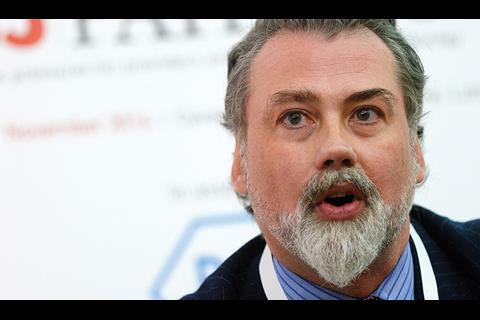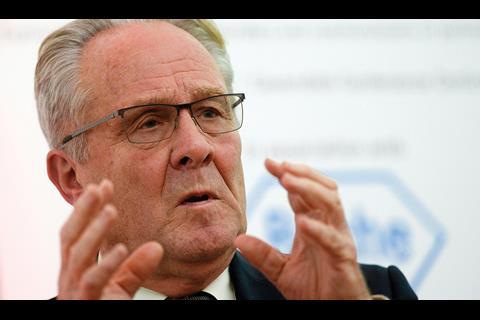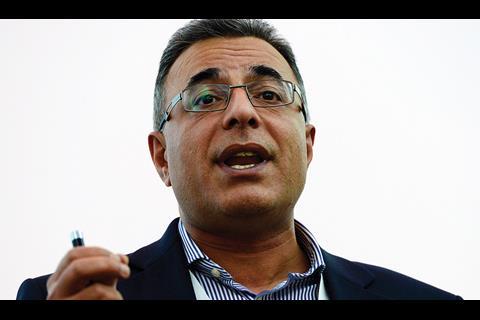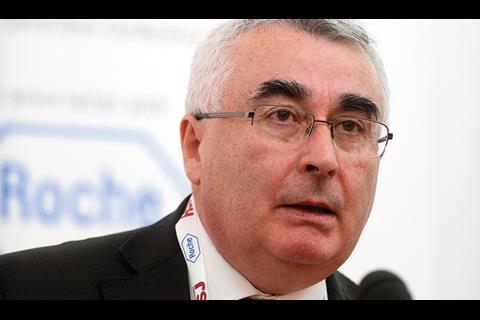Innovation, cost restraints and the restructuring of the NHS are reshaping pathology services. Alison Moore reports from the third annual HSJ/Roche pathology conference
Pathology is facing enormous challenges – but there are opportunities to improve services and cut costs as well. That was the message from the third annual HSJ pathology conference, held in association with Roche.
The event in London in November drew an audience of pathologists, managers and board members from commissioners and providers.
‘In-vitro diagnosis takes only 1 per cent of overall spending, yet 80 per cent of clinical decisions are taken using the results’
HSJ editor Alastair McLellan said the NHS Five Year Forward View, unveiled in October by NHS England chief executive Simon Stevens, stressed the need for new models of care delivery across healthcare and to take action on efficiency.

“That is the world which pathology has been living infor a number of years now,” said Mr McLellan.
“The issues that will be to the fore during the general election – safety, funding, the use of new technology and particularly the involvement of the private sector in the NHS – are issues that are very alive in pathology.”
Big opportunities and barriers
Pierre Hazlewood, director of point of care at Roche, stressed the central importance of pathology in the health service.
“In-vitro diagnosis only takes about 1 per cent of overall healthcare spending, yet 80 per cent of clinical decisions are taken on the back of those results,” he said.
There were enormous opportunities for pathology if some of the barriers could be overcome, he added.
“There is a real desire from all parties involved to work together on this.”
‘There’s a need for additional interpretation and advice on tests from pathologists’
But what are some of the current concerns in pathology and what could be done to improve the service?
Before the conference HSJ had surveyed its readers to get answers to these and other questions. More than 300 people filled in the entire survey, and many more answered a selection of the questions.
One message that came through was that there was a need for additional interpretation and advice on tests from pathologists, said Mr Hazlewood.
This could include advice on which tests to do, when to do them and repeat testing – something mentioned by respondents as an area where money might be saved. There was a need for help interpreting results which showed that pathology was not just a results service, Mr Hazlewood said.
Getting it right
But the survey did reveal some concerns, he added. Respondents saw accuracy, timeliness and interpretation as the three most important factors in pathology services.
But when asked what would most improve services in their area, better support services, such as IT and specimen transport, suddenly leapt into the top three, along with timeliness and interpretation.
“At the moment there is a feeling that results are not quick enough,” said Mr Hazlewood. Many respondents mentioned the impact of this on patients – for example, they might experience anxiety while waiting for results.
And there is the looming issue of providing services seven days a week. One respondent pointed out that GPs were being asked to provide seven day cover but that meant that any samples taken during these extended hours would need to be transported to hospital for processing.
When it came to adoption of new tests, finance was seen as the primary barrier – possibly partly because new tests were seen as an additional cost rather than replacing old ones.
Again, advice from pathologists would be important, said Mr Hazlewood.
‘There is an opportunity for pathology and it is about moving it closer to the clinical decision making pathway’
But there was a broader point about budgets: pathology costs and benefits need to be considered in the wider context of the whole patient pathway, rather than in “silo” budgets.
Only one in eight respondents felt that costs were considered along the entire patient pathway. And awareness of costs was low, even among clinical and laboratory staff.
However, there was some encouraging news. More than half of those responding knew of cases where introducing new tests had led to better outcomes for patients, and nearly 40 per cent knew of cases where adoption of new tests had led to reductions in overall costs.
“There is a great opportunity for pathology to become more than just an ancillary service and to become fundamental in patient pathways,” explained Mr Hazlewood. “I think there is an opportunity for pathology and it is about moving it closer to the clinical decision making pathway.”
Consolidating competition
The impact of competition laws has been felt even more keenly in the NHS in the past couple of years. The new Competition and Markets Authority is responsible for overseeing this and has worked closely with Monitor on NHS issues.
But what will this mean for pathology services, especially as they move towards consolidation in joint ventures, trusts providing services over a larger area, and private providers all changing the landscape?
Tim Geer, assistant director of mergers for the CMA, explained how the authority’s process might impact on pathology reorganisations. The authority has a statutory duty to remedy competition concerns. Its merger review process considers the impact of NHS mergers on such issues as reducing patient choice and adverse effects on commissioners.
But when do competition laws apply in the NHS?
Mr Geer said when a transaction involves two non-foundation trusts the laws did not apply because both of the entities were under the control of the secretary of state. But this changed once one or more foundation trusts were involved.
Organisations can, but are not obliged to, come to the CMA for a review but they could still be investigated if there were reasonable grounds. The first phase of this merger control process lasts 40 days and the second, if needed, is 24 weeks.
The CMA has considered some pathology cases but has not found competition concerns. The legal test is whether there is a substantial reduction in competition that could lead to worse outcomes for patients, commissioners or taxpayers – for example, higher prices or longer turnaround times for tests.
However, Mr Geer added: “It might be the case that a transaction results in benefits.”
He pointed out that Lord Carter had said improved safety and quality and better value for money could come about through a consolidation process.
The CMA has looked at a small number of pathology “‘transactions”, such as those between University College London Hospitals and Royal Free London foundation trusts in 2013, which also involved the Doctors Laboratory, and between Basildon and Thurrock University Hospitals and Southend University Hospital foundation trusts this year, which involved Integrated Pathology Partnerships. Both were cleared in the first stage of the review as the number of providers locally meant there was no issue of competition reduction.
Mr Geer pointed to factors that might influence a review, such as the geographical context of services and how many competitors were within reasonable travelling time.
“We have assessed cold tests in an area one hour’s drive from the laboratory and hot tests up to 20 minutes’ drive,” he said.
“But we don’t say that a provider of cold tests is not included if they are more than an hour away if there is evidence that they are providing services to trusts.”
Another aspect considered is how the market is working locally: is there evidence of switching between providers, for example? What are organisations’ plans for the future and are they credible?
Questioned by Hugh Risebrow, managing director of Synlab UK, Mr Geer said that the recent agreement between Colchester and local trusts to provide services did not fall within the remit of a review as there was not a substantial change in control because the partners in the venture were reasonably equal.
Private partnerships
Joint ventures that involve one or more trusts and a private provider have been seen as a way to get extra investment into pathology and reshape services. But what does it take to get one up and running?
Richard Jones, chief executive of Viapath, was able to offer an insider’s view. He was optimistic about the future for pathology reconfiguration, despite a financial environment that was going to be very tough.
He suggested progress on some elements of Lord Carter’s proposed reforms had been a casualty of former health secretary Andrew Lansley’s reorganisation of health and social care.
Lord Carter had supported consolidation but had also said commissioners should provide a contractual framework that incentivises providers to improve efficiency and outcomes.
He had suggested 20 per cent cost savings could be made, but these were never intended as an end in itself. The money was meant to help with the challenges of innovation and to offer benefits such as new tests.
‘Implementation needs to be driven by patient benefits’
“The cost savings from consolidation were merely part of the business case,” Mr Jones said.
A further issue was that the transformation process had not been driven by the clinical scientific leaders in pathology.
“Clinicians and scientists were not adequately involved in creating the vision for NHS pathology and the benefits were seen as financial not clinical,” he said. Some professionals saw the changes as a threat to pathology.
“Implementation needs to be driven by patient benefits,” he added. Efficiency savings could support investment in genomics and molecular diagnosis.
Viapath is majority owned by two foundation trusts – King’s College Hospital, and Guy’s and St Thomas’. There had been substantial benefits from investing in innovations, and automation had reduced unit costs. Errors in some areas have reduced dramatically and the service operates at a size that allows it to invest in specialist skills from which patients will benefit.
Viapath has generated an operating surplus and this year invested £7m. There was evidence that the venture had delivered quality improvements and costs savings of more than £10m on £100m turnover.
Smart choices
Commissioners will play an important part in reshaping pathology services. Can they take a smarter approach to decision making?
Francisco Munoz, business development director for Integrated Pathology Partnerships, said pressure on services would remain after the general election, as would the challenge to save money and move services into the community. He suggested there would be more integration of pathways and pathology would have a role to play.
Patients who want to self-manage conditions would also impact on pathology.
He said: “More and more people are embracing the electronic era. People want to see their results and take them with them.
“How can we as pathology providers support that integration?” he asked, raising the question of the level of support needed to help GPs decide which tests to order and the appropriateness of different ones.
One possibility might be benchmarking against their colleagues as rates of testing varied by a multiple of 10.
‘Rather than looking at the cost of pathology, we looked at the value of pathology’
Some changes in pathology services could also support wider aims of the NHS – for example, point of care testing in community services might help avoid admissions. With ever increasing admissions in the NHS, pathology had a chance to be an enabler of change.
Jan Ledward, chief officer of Greater Preston, and Chorley and South Ribble clinical commissioning groups, and Martin Myers, clinical biochemist at Lancashire Teaching Hospitals Foundation Trust, talked of the challenges ahead.
Ms Ledward said she was looking for opportunities within the health economy to create value and improve patient experience in an area in which too many people died too early, and there was inefficiency and waste.
The enablers of improvement would be upscaled general practice, integration, vibrant teaching hospitals and a conversation with the population.
Among the changes implemented by the CCGs was a move towards a more high tech environment, shared patient records and increased direct access to diagnostics.
Mr Myers said: “Rather than looking at the cost of pathology, we looked at the value of pathology.” The CCGs were trying to be clinically aligned with best practice and move away from silos.
From back room task to clinical service
For the third year running Roche has worked with HSJ to host a seminar for those involved in pathology, whether as providers or commissioners. We were delighted to welcome so many delegates to debate the way forward for pathology and to contribute their different perspectives on some of the current issues.
This supplement aims to bring these debates to a wider audience and highlight some of the key points. What stood out at the conference was that the Carter reports into the future of pathology services, published several years ago, were not just about cutting costs but about providing high quality, safe services. Where this could be done at lower cost, these savings could offer an opportunity to invest in new technologies and improve patient pathways.
We believe collaborative partnerships offer a way to achieve this against the challenging backdrop of an NHS that faces ever growing demand and financial restraint. Demographic factors such as people living longer and with long term conditions will only increase the pressure.
At Roche, we hope to play a part in supporting the coming together of the different groups across the patient pathways. Pathology transformation certainly won’t happen without the input and informed discussions between the pathology stakeholders: the clinical teams and budget holders across both primary and secondary care.
But at the centre for all partners has to be the best interests of the patient. Pathology has too often been seen as a back room function, removed from hands on patient care. However, pathology has a crucial part to play that goes beyond just its role in carrying out tests and delivering results. Its added value lies in its effect on improving the clinical care offered to patients.
Pathology staffs’ skills in interpreting tests, advising on which ones should and should not be done, and contributing to clinical discussions about diagnosis and treatment need to be recognised for what they are: a clinical service.
Investment in pathology can both improve care and reduce costs in other areas. We hope you enjoy reading this supplement and get involved in the debate around the future of pathology and what it has to offer.
Paul Skingley is director of hospital in-vitro diagnostics for Roche
Consolidation and scale
One of the hot issues in pathology over the last few years has been the establishment of services spanning several trusts in the East of England.
Andrew Knott, commercial director of the Pathology Partnership, which grew out of the Transforming Pathology Programme, said this had taken three and a half years but was now providing services for three million people.
“The [strategic health authority] was market oriented and looked towards this to drive change,” he said. “It was a very cunning proposition.”
There was a threat that trusts could lose community work, which made them realise they needed to provide a sustainable service through a hub and spoke approach. The SHA was abolished midway through the process. However, CCGs saw the clinical benefits of the transformation and the programme went ahead. It now involves a joint venture between seven trusts in the region.
Were there lessons for other areas? One was the length of time the bid process had taken and the difficulty in getting investment in transformation until there was a contract in place. Uncertainty during the process had affected staff.
“The HR challenge to all of this can’t be underestimated,” warned Mr Knott. “You also need to be honest and recognise that transformation is not welcome news to staff who are required to move location or who potentially no longer have a role.” But the process also presented opportunities for staff.
“It is often the staff on the ground who are best placed to identify when there are blockages,” he said.
‘Staff on the ground are often the best placed to identify when there are blockages’
But he cautioned other regions: “Don’t be wildly ambitious about the time scale.
In our case there was an expectation that the service, including IT, could go live almost straight away.”
The length of the contract was also important to make investment worthwhile. In this case the original suggestion had been a two year contract with a potential two year extension. “But two years to pay back the costs of transformation would not make sense,” added Mr Knott.
He pointed out the potential for conflict between the drive for consolidation in pathology and competition regulations. Showing that there was not substantial impact on competition could be “time consuming and really expensive”.
“I potentially see the competition hurdle as being the biggest barrier to pathology consolidation today,” he added.
It was also important to get the buy-in of trusts, which required them all to share in the benefits. But with a three year lead-in period, there was always going to be turnover among senior trust executives so it is important to engage with non-executives as well.
There would also always be a difference in the priorities trusts gave to particular projects.
“If one trust believes it is losing out, there is a fair chance it will walk,” said Mr Knott. “Trusts need to understand where compromises are required. Never underestimate the complexity of planning and delivering any transformation.”
Paula John, biomedical scientist and quality manager for the Pathology Partnership, highlighted some of the differing attitudes to change encountered when trying to transform services.
“Some people embrace it, some fight it and some run away,” she said, adding that staff were often an untapped resource and needed to be supported to make changes.
Lord Carter on policy
Lord Carter gave the keynote speech at the seminar and reflected on the changes that had and had not occurred in the six years since his second report into pathology was published.
“I really wanted to make an incremental change,” he said.
But since his second report, there had been three different secretaries of state.
He suggested that “NHS time” differed from “normal time”.
“You have to factor in that you are dealing with a very big system,” he said.
Although he was passionate about the NHS and regarded it as the best system in the world, he thought there were savings to be made in pathology.
He cited one hospital that had made major investments in equipment just to cope with the timing of specimens arriving at the laboratory, rather than looking at how they could arrive in a more timely manner.
Globally, other health economies had tackled some of these issues some time ago.
“I would rather be remembered for saying something about quality than cost,” he said. “But high quality and low cost travel together. Good management knows how to deliver good quality and control costs.”
Why is reform always ‘just round the corner’?
The conference ended with a wide ranging question and answer session. HSJ editor Alastair McLellan remarked on the consistent themes across the last three years: the reshaping of pathology services which was always just around the corner. In a year’s time would things have moved on, he asked.
The coming election may mean that people are not moving forward at the moment, but that there could be movement after that. Jan Ledward, chief officer of Greater Preston, and Chorley and South Ribble clinical commissioning groups, said collaboration “is hard to do and takes time”, and could be difficult to get across a large area.
Paul Skingley, director of hospital in-vitro diagnostics at Roche, said much previous discussion had been around form.
He said: “I am more optimistic because what I see on a day to day basis is the moving away from form to what we want a pathology service to do. I think that is a more progressive conversation.”
But were clinicians getting more engaged in change?
Manu Vatish, senior clinical fellow and obstetrics consultant at Oxford University Hospitals Trust, said: “It is very difficult. We want to introduce a test but there is no one in charge. It’s all good until that point.” There could be big savings from admitting fewer women with high blood pressure during pregnancy (see box, opposite page) but it was a struggle for the trust to release funds upfront to pay for the tests that would help to do that.
Another panel member joked: “If the NHS was an economics student, it would have got a first in microeconomics and failed in macro.”
Francisco Munoz, business development director for Integrated Pathology Partnerships, said clinicians were sceptical of partnerships, but having control over budgets allowed them to develop business cases for new tests with a focus on whole health economy benefits.
Mr McLellan asked whether there was a need for national intervention to accelerate efficiencies. Suggestions included investments in IT and change management, as well as funding to help trusts through a period of transformation when costs might actually increase.
Ms Ledward stressed the need for a longer timescale: “We have a very short term approach to delivering on improvement. It often takes longer than 12 months.”
“But is there too much competition, too much collaboration, or not enough of both?” asked Mr McLellan.
Richard Jones, chief executive of Viapath, said there was a need for more contestability and primary care was important in that. Concerns about instability in local trusts’ services could be a block and everyone wanted to collaborate, as long as they were the hub.
Andrew Knott, commercial director at the Pathology Partnership, said a pathology directors’ forum had helped.
Concluding, Mr McLellan said: “I think there is some movement. I suspect that, when we come back here in a year’s time, we will be discussing some real change afoot.”
It had been hard to get key people on board: one SHA chief executive, when told that improvements could reduce costs by £38m, pointed out that he had a £5bn budget and trying to reduce pathology costs would upset people, before indicating that the project would be on the back burner.
“Earlier this year he sought me out and said he wished he had had that £38m, as he could have done more for patients,” said Lord Carter.
But what of the position today? Lord Carter identified the challenge of getting “head room” to deal with some of the issues in pathology.
However, it was a growth area with a 10 per cent increase in tests each year.
He suggested commissioners ought to be interrogating providers as to whether both price and quality were right.
“I have been disappointed with the performance of commissioners in getting stuck into pathology. I see them as absolutely central as they provide the money,” he said.
“As the metrics become clearer, someone is going to say: ‘why are we spending more than the national average?’
“We are in a very difficult place economically. I have no doubt that people like yourselves and the management of the NHS will make the right decision.”
‘We can’t just go for money. We have to get the quality right’
He agreed with questioners that there were challenges in understanding costs, saying that it had taken nine months to get data recorded in the same way for an organisational review and that it could be difficult to look at staff costs.
He said: “I think there will be consolidation over time but at a pace that professionals are happy with and with great data.”
HSJ editor Alastair McLellan asked whether there was a gap between a pace that the NHS was culturally happy with and the pace it needed to go.
“It seems to me that the burning platform we face will hasten the pace of change,” answered Lord Carter.
“We can’t just go for money. We have to get the quality right.”
People and progress
Partnerships are seen by many as crucial in the consolidation of pathology.
Paul Skingley, director of hospital in-vitro diagnostics for Roche, said the Carter report made more than a call for savings.
“It was about increased quality and increased clinical engagement,” he said.
But the question now was how to take this forward. How could collaborative partnerships come about without a system manager?
The challenges the NHS would have to face in the future included increased population, more older people and changes in the ratio of working to non-working people.
There were also vested interests and people who were simply happy with the status quo. Transformation was needed to deliver savings.
Industry and healthcare providers could work together and this had been demonstrated in initiatives such as telehealth in the north east.
Industry could offer experience of working across boundaries.
“It is about taking pathology out of the lab,” said Mr Skingley. “It is about taking the expertise out of the lab and closer to patients.”
“Fundamentally, we are providing a clinical service and it is all about people.
“It is not just a testing service. Industry has a part to play in that but that relationship will change from project to project.”
Test pinpoints those with pre-eclampsia
A practical example of the potential of pathology innovations to improve care and change pathways is in the diagnosis of women suffering from pre-eclampsia.
Pre-eclampsia is a common complication of late pregnancy. Pregnant women with symptoms such as elevated blood pressure are often admitted to hospital, have extra monitoring and may be classified as high risk, which can affect the type of birth they are offered.
Women with high blood pressure occupy half the beds in some obstetric units.
But some of these women are not at risk of developing pre-eclampsia and their symptoms may have another cause. Research has shown that the ratio of two proteins can show whether or not pre-eclampsia is the cause.
“It is a really good negative predictor,” said Manu Vatish, senior clinical fellow and obstetrics consultant at Oxford University Hospitals, who has been involved in developing the test.
“We can send people home. We can see them when they present, take a blood test and, if it comes back as a low ratio, we don’t have to admit. We can see them again in a week,” he explained.
“This represents a particularly useful test for the future. Working out how this will be funded is a more interesting issue.”




































No comments yet